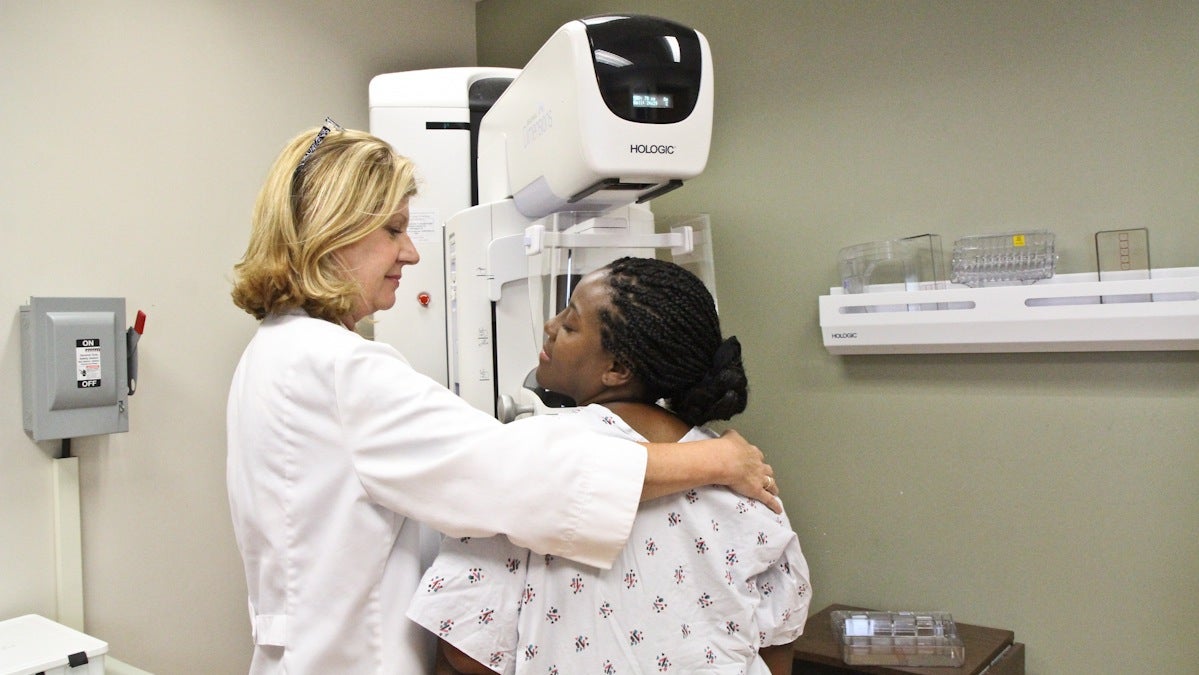New mammogram guidelines: Why can’t we all just get along?

Chief Technician Donna Burke demonstrates how a mammogram is given with the help of Sharon Born
New mammogram guidelines were recently issued by the U.S. Preventive Services Task Force (USPSTF), and, unsurprisingly, they have not been greeted with open arms within the health community.
“New breast cancer screening guidelines could be deadly” and “Some Doctors Say New Mammogram Guidelines Are ‘Dangerous‘” are among the recent headlines highlighting the new recommendations. Organizations such as the Pennsylvania Breast Cancer Coalition openly oppose the Task Force’s guidelines.
This issue isn’t new. Just last year we reported on the ongoing disagreement over the appropriate age to initiate mammography. Similar debates rage in the prostate cancer, lung cancer, and cervical cancer worlds.
It makes you wonder: if we all have women’s best interests at heart, why all the controversy?
Let’s first take a step back and look at the new guidelines.
Women ages 40-49: The decision to start screening mammography should be an individual one. Women who place a higher value on the potential benefit than the potential harms, may choose to begin screening every two years. Women ages 50 to 74: Screening mammography every other year.Women 75 and older: Insufficient evidence to make a recommendation.
These recommendations are more conservative than those of other organizations. The American Cancer Society, for example, recommends that women should begin screening earlier, at age 45, and get mammograms every year until age 55. Women aged 55 and older are recommended to switch to screening every two years or choose to continue with yearly screenings.
How can two organizations look at the same evidence and come to different conclusions? There are three main reasons why, when it comes to breast cancer and other screening guidelines, we don’t all agree.
1. The evidence is messy.
There is a massive amount of evidence, and new studies are constantly pouring in. And analysis of the plethora of data is not simple arithmetic.
For example, the relevant studies use different study designs, making them difficult to add up. In the case of mammography, greater benefit has been seen in observational studies than in the gold standard randomized controlled trials (20 to 40 percent vs. 15 percent). The relative weight given to each type of study is critical to the outcome of the analysis.
“‘Get a mammogram, don’t get a mammogram’ … it’s all about how you slice and dice the data,” says radiologist Emily Conant, head of breast imaging at Penn Medicine.
2. Weighing of risks and benefits is subjective.
Once all the numbers are added up, the risks and benefits must be balanced, which requires placing a value on each of those risks and benefits.
“I don’t know many women with cancer who wouldn’t have happily traded a year of nausea, exhaustion and hair loss for the stress of a false positive,” gynecologist Dr. Paula Bernstein wrote to the Los Angeles Times in a criticism of the new recommendations.
But of course it’s not a simple comparison of one false positive versus one delayed cancer diagnosis. The questions are much trickier. How many false positives are we willing to hand out in order to catch one early tumor? How many biopsy complications are worth one early diagnosis?
Therese Bevers, chairwoman of the breast cancer screening and diagnosis guidelines panel for the National Comprehensive Cancer Network, disagrees with the USPSTF recommendations and acknowledges the discordance in value judgment. “We just feel that the task force [value] placement on the harms is a bit excessive,” she told the Wall Street Journal.
As is the case with any subjective value judgment, bias must be considered. An individual who suffered the emotional trauma of a false positive may be biased toward more conservative screening, and an oncologist who routinely treats advanced tumors may put more weight on importance of early detection and thus advocate for aggressive screening.
3. The individual vs. the population, and politics.
Guidelines must not only consider the risks and benefits to the individual, but they must take into account the pros and cons for the population as a whole.
Cost is particularly relevant to this issue because this is where the good of the individual is often at odds with the good of the population. An example might be a test or procedure that would provide a small net benefit to a patient but is very costly to the healthcare system. Consideration of cost and allocation of resources is an unfortunate reality in a system with limited resources. It is also is a hotbed for controversy.
Debra Monticciolo, chair of the Breast Imaging Commission of the American College of Radiology, points to “an unfortunate political component to recent U.S. Preventive Services Task Force mammography guidelines,” in a letter to the Washington Post.
“[T]he Affordable Care Act requires a grade of B or higher from the task force to guarantee mandatory insurance coverage for any medical exam,” whereas the USPSTF guidelines give the evidence for screening younger women, aged 40-49, a C. “Whether the task force intends its decisions to affect coverage or not, these recommendations could result in millions of women being stripped of coverage for mammography.”
Gynecologist Dr. Paula Bernstein in a letter to the Los Angeles Times was more blunt. “Pardon my cynicism, but this isn’t about stress; it’s about money.”
When it comes to any type of healthcare guidelines, whether it’s breast cancer screening or whether or not to take a daily aspirin, it can be hard to know whom to trust. These guidelines are simply the latest round of recommendations meant to guide patients through challenging and important decisions, but ultimately, it’s up to the patient and doctor to decide what’s best.
WHYY is your source for fact-based, in-depth journalism and information. As a nonprofit organization, we rely on financial support from readers like you. Please give today.



